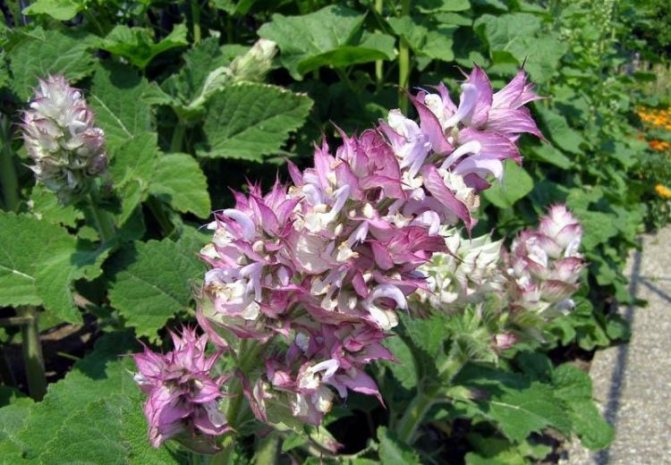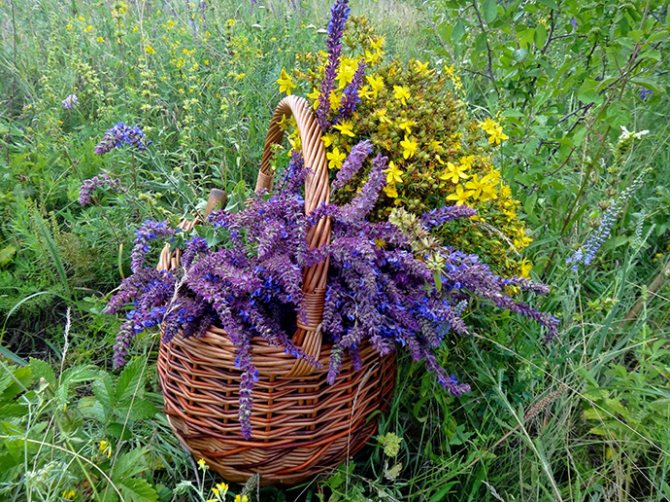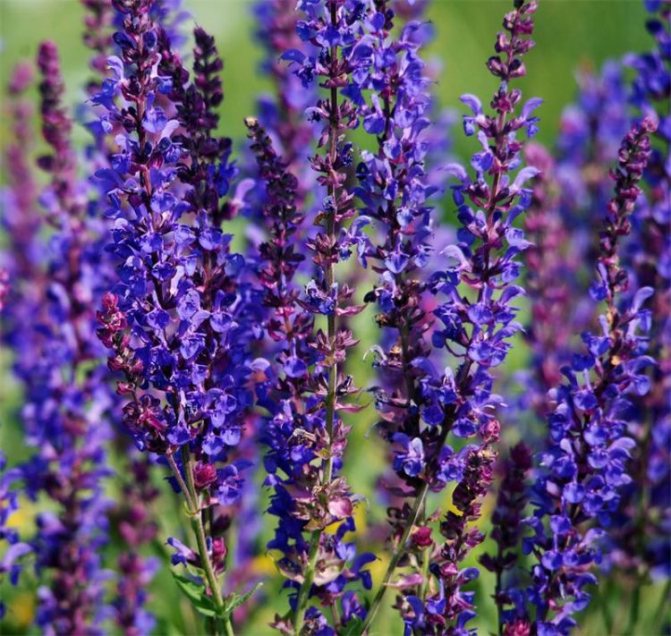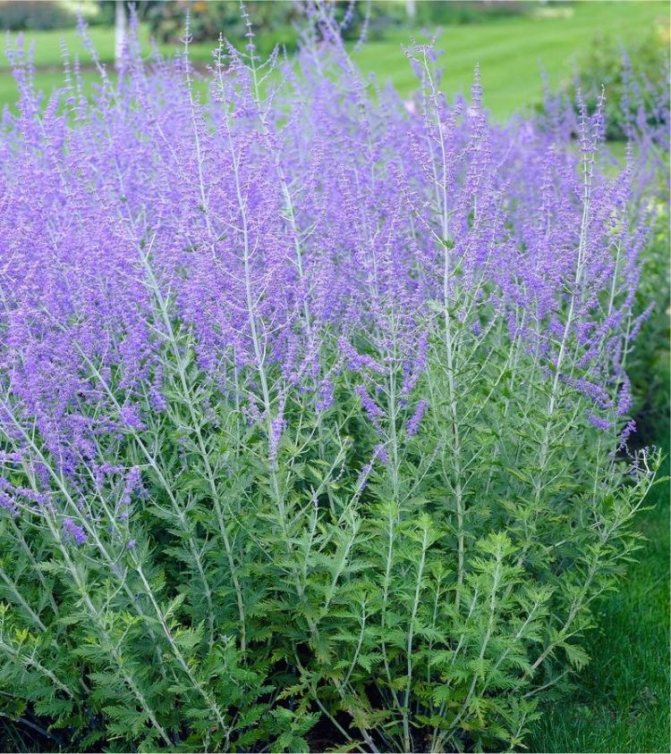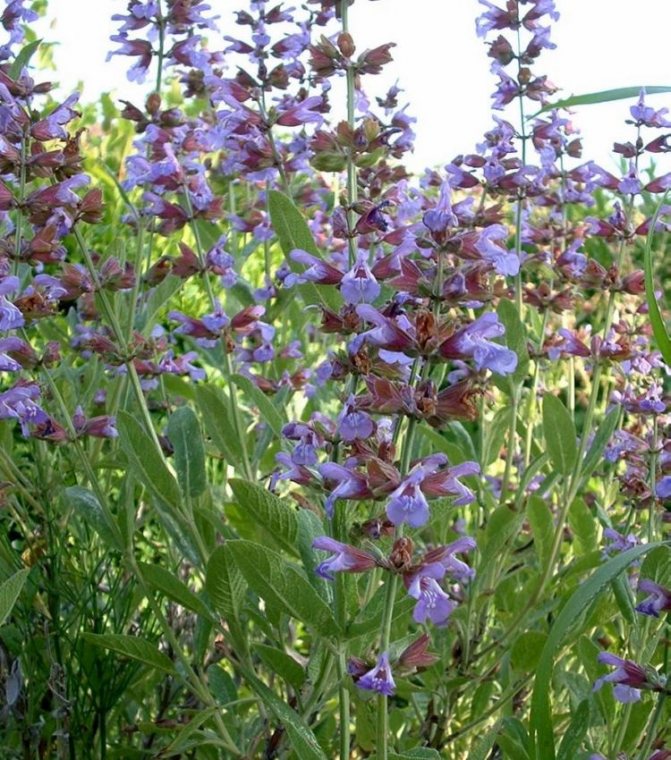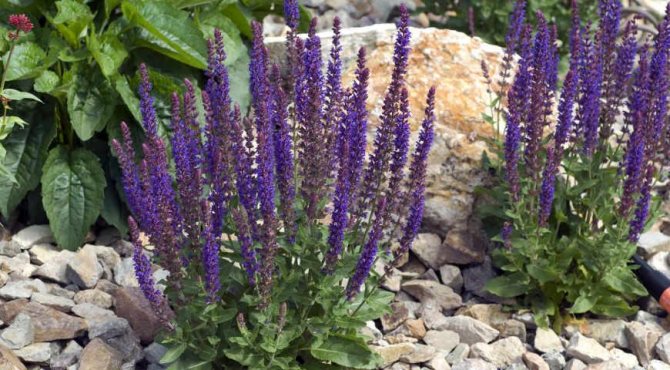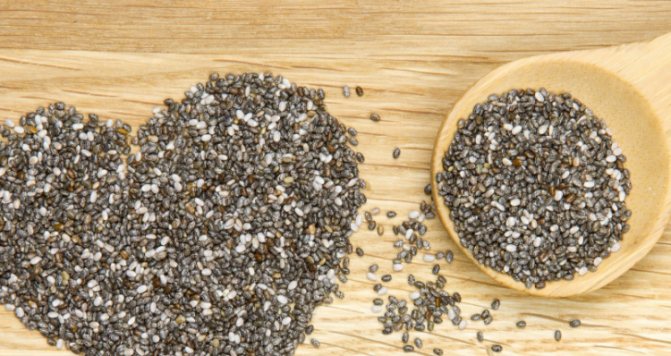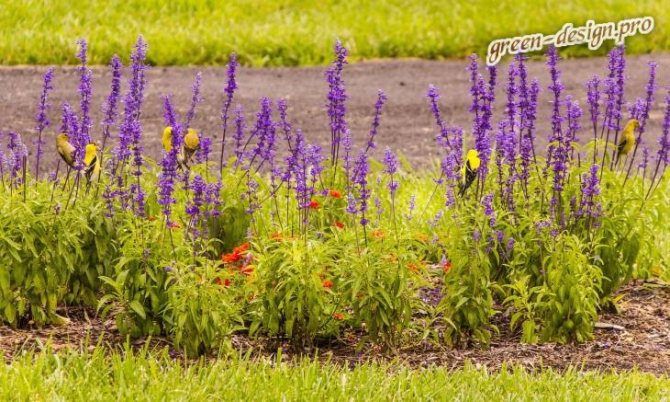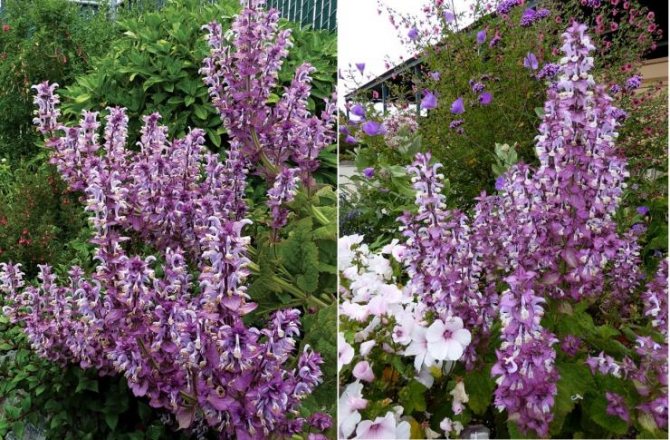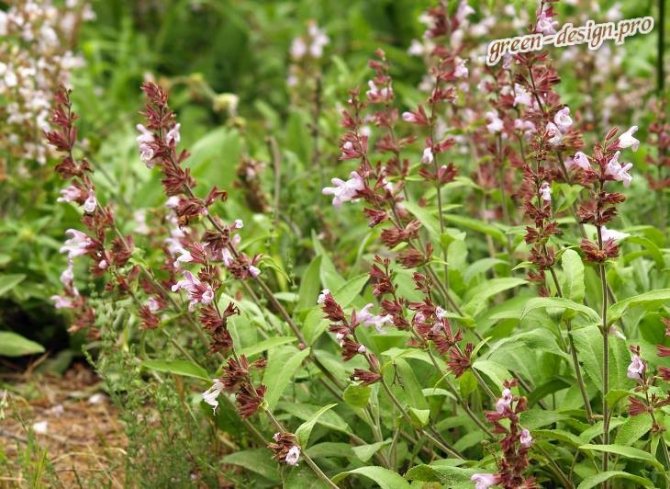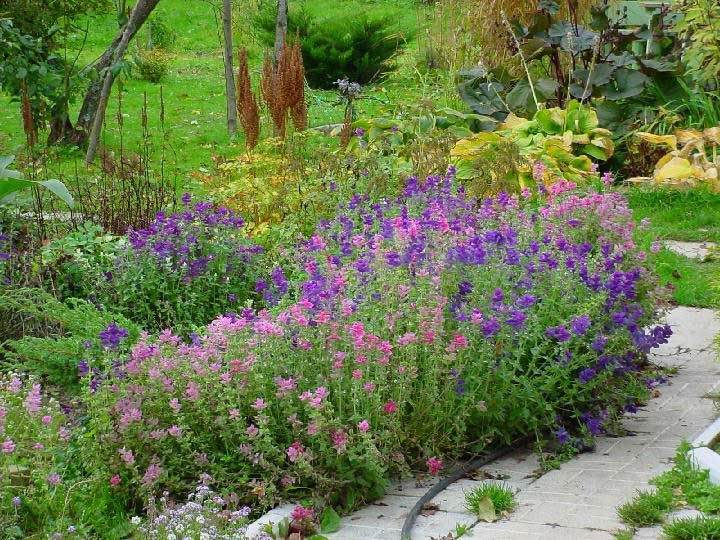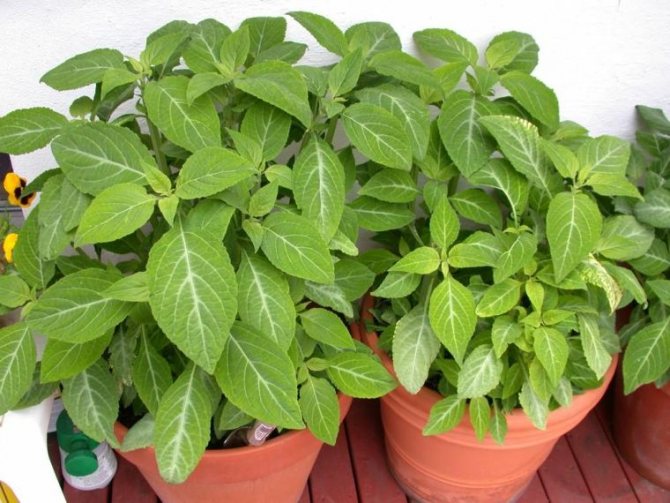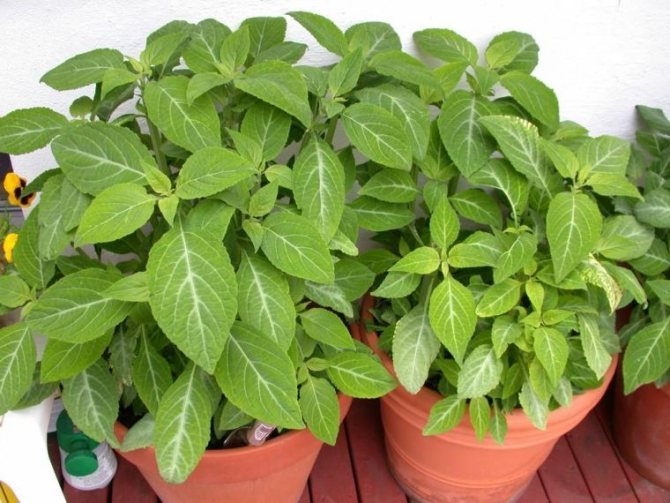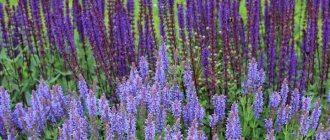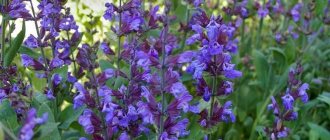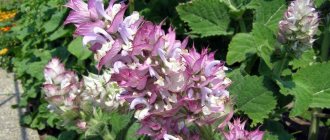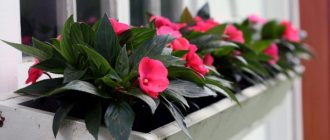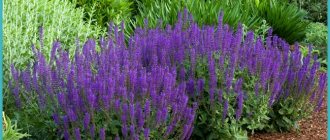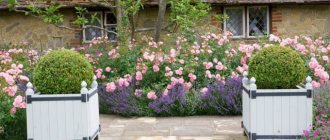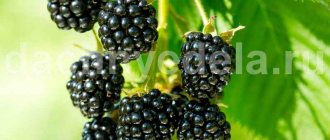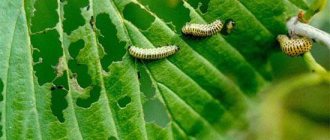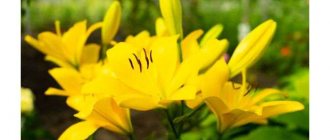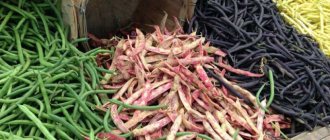An unpretentious and beautiful plant is not yet so often found in summer cottages. But in vain! Sage - another name for it salvia - has an attractive appearance, is an excellent honey plant, and its medicinal qualities have been known since time immemorial.
Its decoctions are used in dentistry, used for rinsing the mouth for toothache and gum disease. Douching is prescribed for gynecological diseases. Aromatic oils are used to treat colds. Sage is found in many medicines and culinary spices.
So, sage - planting and care in the open field.
Sage: cultivation features
At the same time, it is not difficult to grow sage. This can be done even indoors. But still a more suitable option for a plant is open ground. In warm countries, sage is grown as a perennial plant. In Russia, often, it is bred as an annual, since due to cold winters, and even with a small amount of snow, sage can freeze out. But with careful care, this will not happen.
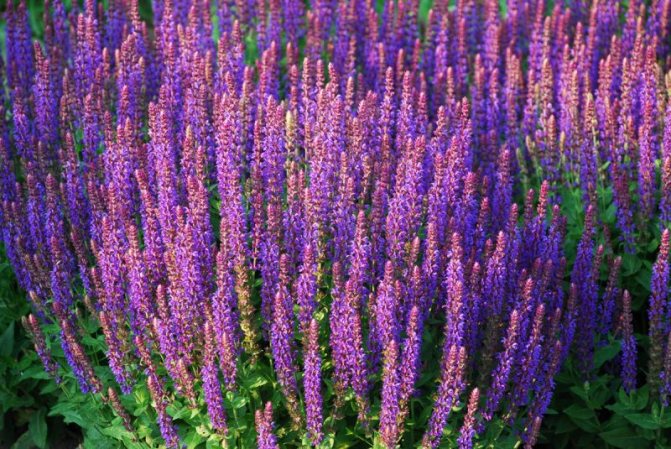
In Russia, you can grow clary sage, medicinal, meadow, oak.
Sage species, a short description
There are many types, but four are the most common.
Clary sage
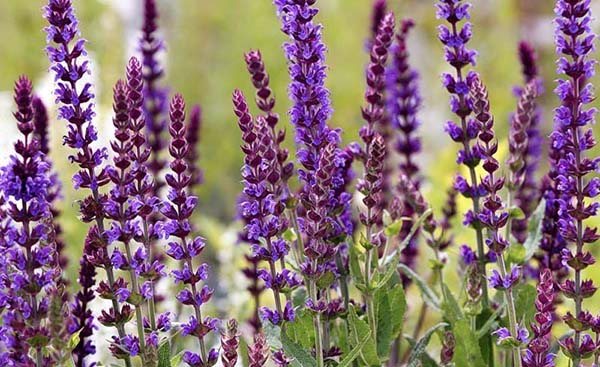

Clary Sage / Salvia sclarea
The plant is a perennial shrub up to 1m 20 cm high. There are light hairs on an erect stem. The leaves are long, oblong, almost 30 cm, and the width is about 2 cm. The plates are wrinkled, with sharp tips.
Clary sage inflorescences are in the form of a panicle or spikelet. Flowering is long, almost all summer. In place of the flowers, seeds are formed in the form of a nut with a diameter of 3 cm.
The plant is widespread, and sage can be seen in the wild. They are used in cooking, in the production of wine and vodka products for aromatization. The leaves are used in folk medicine. Dry sage is sold in pharmacies.
Oak sage
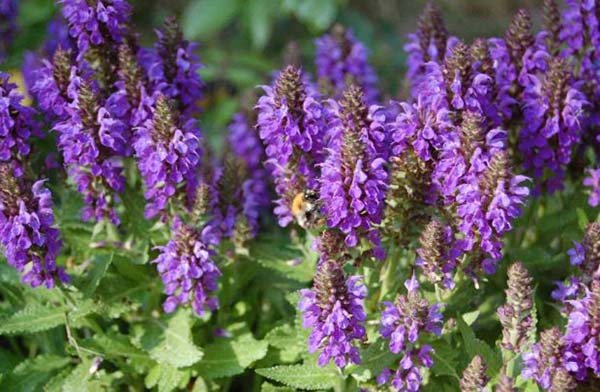

Oak Sage / Salvia nemorosa
This plant has other names - Moldavian, Yaylinsky. This type of salvia is not only decorative, but also an excellent honey plant. The plant is thermophilic, therefore it is grown in warm regions.
The perennial shrub pleases with its pink flowers all summer until the first frost. Depending on the variety, they grow up to 30-70 cm. They are used in cooking, as a seasoning for various dishes and when pickling cucumbers.
The leaves are dried, ground into powder or crushed into small pieces. Dishes seasoned with oak sage acquire a piquant bitter aftertaste and become aromatic. Salvia is used in medicine, in the manufacture of cosmetic and perfumery products.
The plant is rich in carbohydrates and dietary fiber, proteins, fats, ash. In terms of the presence of trace elements, there are few medicinal herbs that could compete with sage.
Dry leaves are rich in:
- potassium and magnesium;
- calcium and phosphorus;
- sodium and manganese;
- iron and copper;
- selenium and zinc.
Meadow sage
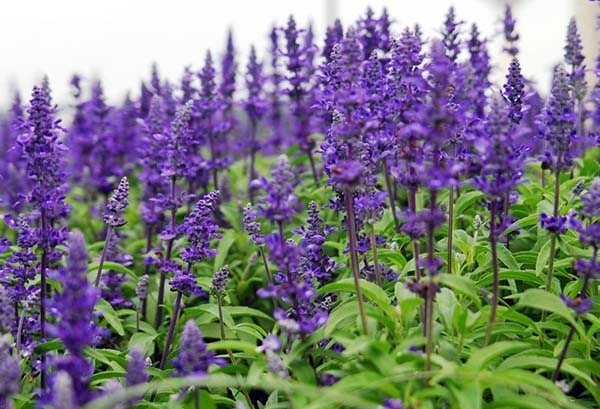

Red Sage / Salvia pratensis
This type of medicinal plant grows in the wild in all European countries. The leaves are used in cooking in the preparation of salads, soups, broths, as well as in canning vegetables. Feels good in gardens too.
Desert sage
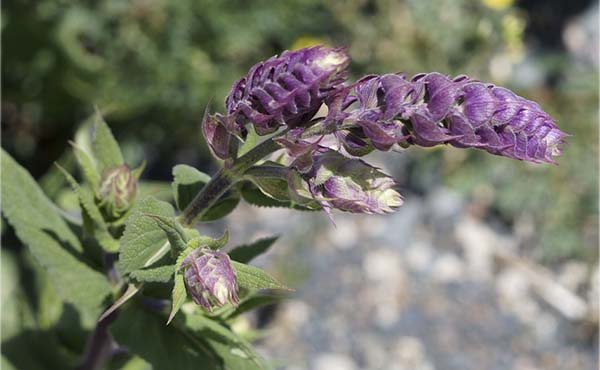

Desert Sage / Salvia deserta
On the territory of Russia, this plant is widespread in Altai. This is an excellent honey plant, over which bees buzz all summer, collecting nectar. Salvia is grown as an ornamental plant in personal plots.
Landing in open ground
Many gardeners grow sage from seed in seedlings, or purchase seedlings from the market. But an unpretentious plant can be planted directly into the ground. Let's talk about this in more detail.
How and when to plant?
To grow seedlings from seeds, planting begins in the first decade of March. Subject to all the rules, seedlings will appear in 14-20 days. Seedlings can be transplanted into the greenhouse in May, in open ground - in early June.
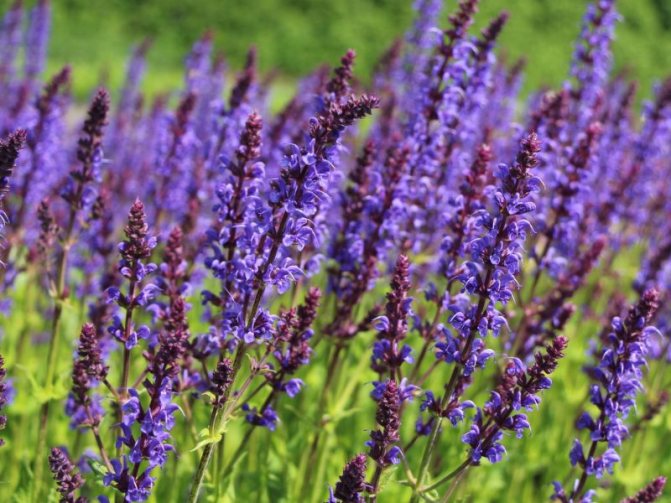

Seeds can be planted directly into the ground either in the fall - in October, or in the spring (preferable), during May.
Soil preparation and site
Sage does not require particularly fertile land and grows on almost all types of soil. It responds best to planting in loam, especially if lime and humus were previously introduced into it.
Before planting it is required to "lighten" only the clay soil. Otherwise, in such a heavy soil in a rainy summer, the roots of the sage will rot, and in winter they can freeze out. To prevent this from happening, the earth is dug up ahead of time, bringing humus into it, and only then they start planting plants.
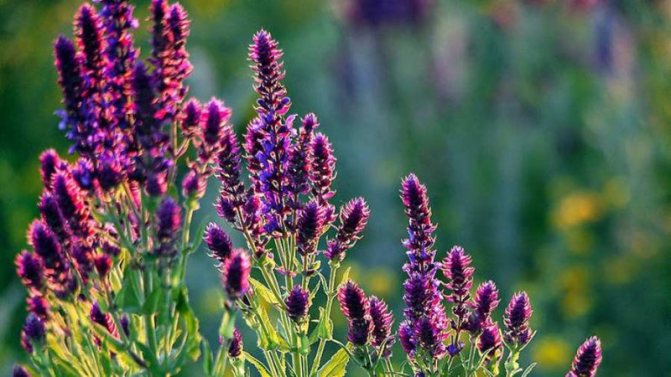

It is good if the summer resident can allocate a place for his "plantation" of sage on the south side of the site, in a sufficiently illuminated place. But you should not plant near the house. Icicles melting in spring and rain flowing from the roof in summer will create excess moisture in the soil, which will negatively affect the condition of the roots.
In the central and northern regions of Russia, sage needs to be sheltered for the winter period, often it is necessary to add snow from above. So those places on the site that are cleared of snow in winter are also not suitable for planting a plant.
But the areas next to the garden paths are very convenient. If sage grows here, you can fully enjoy its scent. Please note that with good care, the bushes can rise up to a meter in height, and reach half a meter in diameter.
Planting by seeds or seedlings
The easiest way to grow sage is by planting seeds for seedlings in March. Before that, they are soaked in water - warm or room temperature - for 24 hours. After that, for disinfection, they are kept in a weak solution of potassium permanganate for several minutes.
Suitable for planting any of the ready-made soil for flowers, which are sold in the store "Nature". The seeds are planted to a depth of about 2 mm. In order for the seedlings to appear earlier and to be uniform, it is advisable to close the box with a film. Periodically, it should be raised for 10-15 minutes so that mold does not appear on the soil.
Care in the garden
Sage care is usually straightforward, even for novice gardeners.
Watering the plant
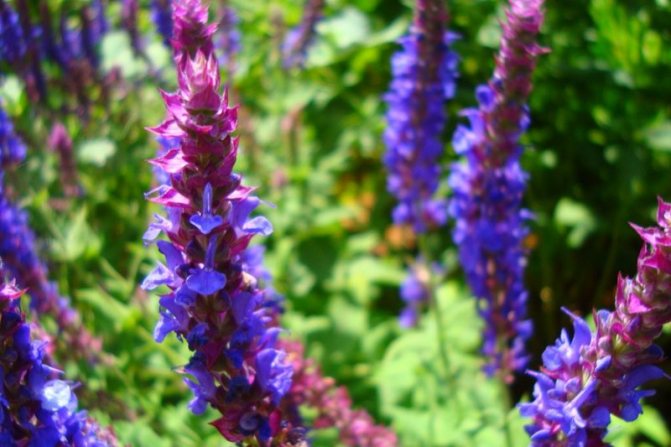

Plants should be watered as needed, in hot weather 1 time in 3-4 days. It is better to do this in the evenings so that the plant does not get sunburn. It is preferable to use settled water, water from a watering can - in moderation, so that the water does not stagnate and the roots do not start to rot.
Top dressing and fertilization
Top dressing is applied approximately once every 3 weeks. You can use manure diluted in water in a ratio of 1:10, infusion of herbs, nettle, peat, humate are especially good.
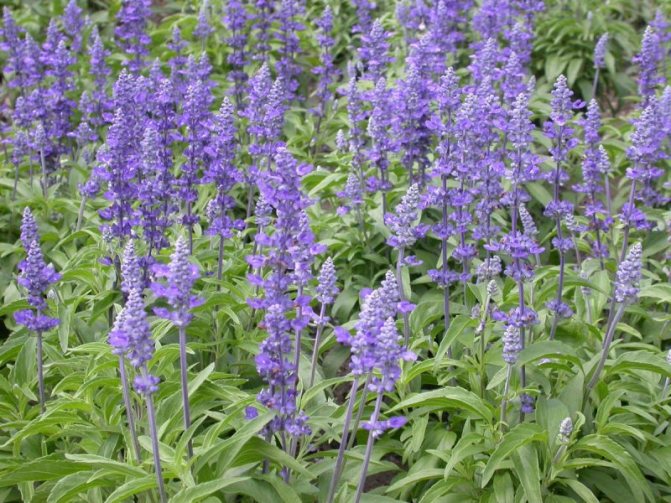

Mineral fertilizers - nitrogen, potassium, phosphorus - are applied in September, during the digging of the site.
Loosening and weeding
Sage grows slowly, so it is important to protect it from fast growing weeds.
If the planting was carried out directly into the ground with seeds, then the aisles should be loosened even before the emergence of shoots.
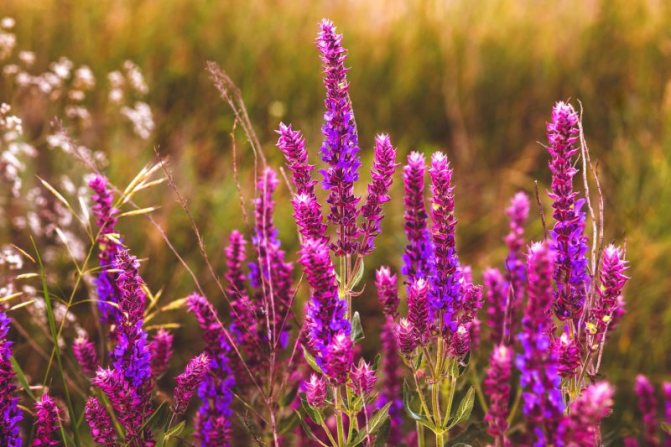

When the sage has risen, the beds are weeded. If the seedlings are thickened, they are thinned out.
Usually, weeding should be done at least 3 times over the summer. Loosen the soil as needed, carefully enough not to damage the sage root system.
Sage pruning rules
The bushes of the plant will have to be cut off periodically, otherwise the sage will stretch out, begin to age quickly, and will not give a good harvest of medicinal raw materials.
After pruning, new shoots will develop intensively.
When flowering is over, cut off all dried inflorescences. In spring and autumn, the bushes are cut. It is imperative to remove woody shoots.
How to transplant correctly?
Sage can grow up to 30 cm in height during the summer. Flowering usually ends in mid-July. If the plant is grown as a perennial, it should be transplanted to a new location every 5 years. This is done so that in subsequent years the sage will delight the owners with abundant flowering.
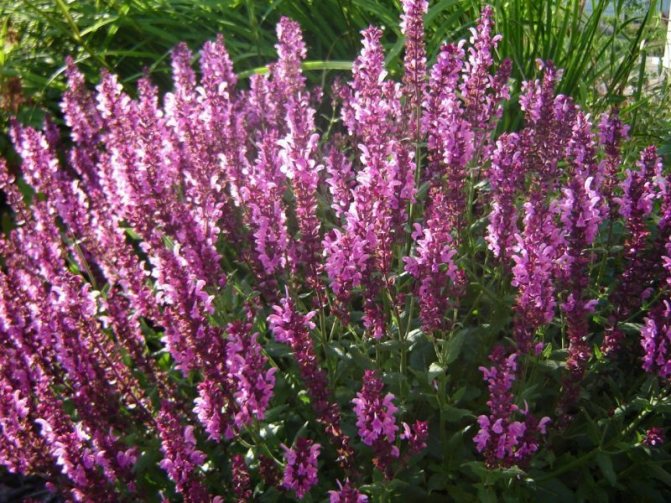

You can transplant the plant in spring or autumn. You should remember about a powerful root system and do the work, trying not to damage the roots.
In the process of planting, complex fertilizers are introduced into the hole.
Autumn care and preparation for winter
The main danger for sage is the frosty Russian winters. Therefore, when the air temperature drops to minus values, the plant is pruned so that it is easy to cover it for the winter. For this purpose, you can use fallen foliage, spruce branches, covering material.
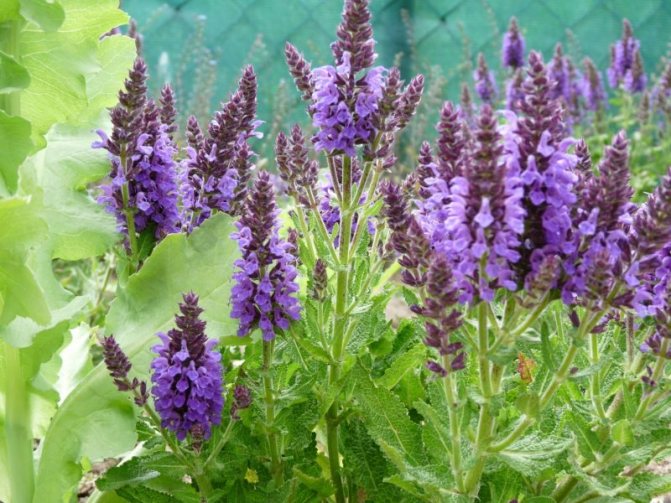

Caring for sage for the winter is easy. Make sure that there is enough snow on the site. If necessary, fill it up.
Winter crops in November
A very hot season awaits us in the spring. But we can unload ourselves a little by sowing some of the plants before winter. I think that many gardeners and gardeners have used this technique more than once. This sowing time has both pros and cons. So let's try to figure out "what is good and what is bad."
Let's start with the fact that for some plants this is the ability to just get seedlings - for those whose seeds are in a state of deep physiological dormancy and will not germinate for several months without cold exposure. Such fastidiousness includes yellow gentian, barberry, hawthorns and some other woody and shrubby plants. If you are a fan of growing seedlings of fruit trees on your own, then you can sow an apple tree, a pear tree to get seed stocks.
Some plants, for example, all aralia plants (eleutherococcus, aralia, zamanihu, ginseng), as well as wild garlic and adonis, had to be prepared in advance for cold immersion for 2-3 months by warm stratification at room temperature. Of course, you can keep them in the refrigerator for 5-6 months and sow in spring, but there the seeds often grow moldy, they need constant supervision and, if necessary, treatment against mold, most harmlessly with a solution of potassium permanganate.
For some plants, this is the ability to get earlier shoots... Having prepared the beds in advance and cut the grooves, in early November, when the soil freezes, you can sow dill, parsley, parsnips, lovage, coriander, tricolor violet, elecampane.
Sage in landscape design


Sage is widely used in landscaping, especially blue-flowered plants.
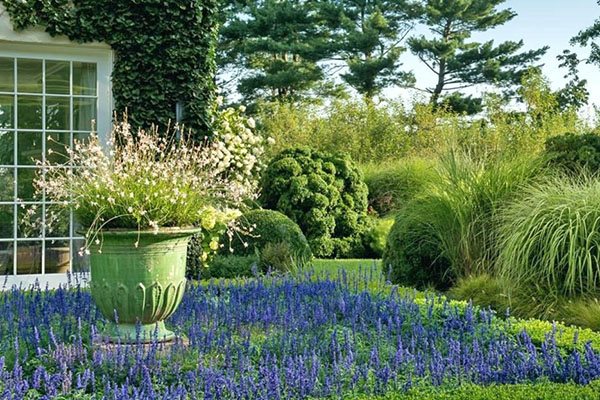

They are capable of visually increasing the gaps between plants, as well as giving the flower bed incredible shades.
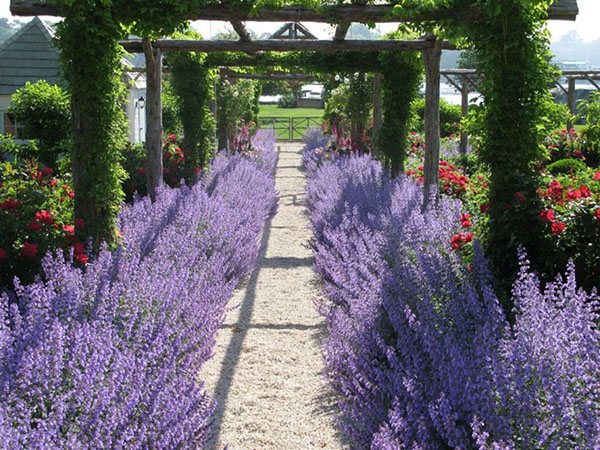

Sage blooms all summer, so it fits very well into those flower arrangements where a lot of autumn and late plants are collected, for example, asters, heliops, daylilies.
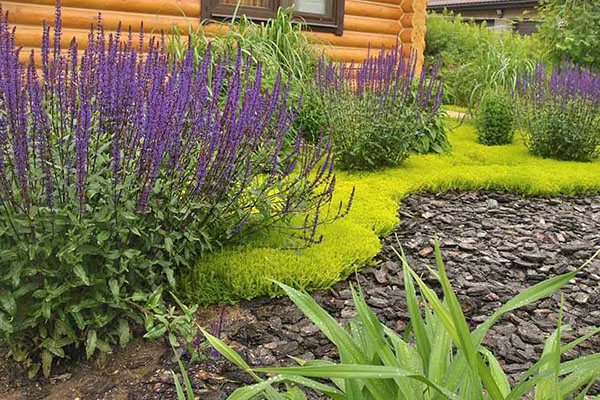

Compositions from sage, daylilies.
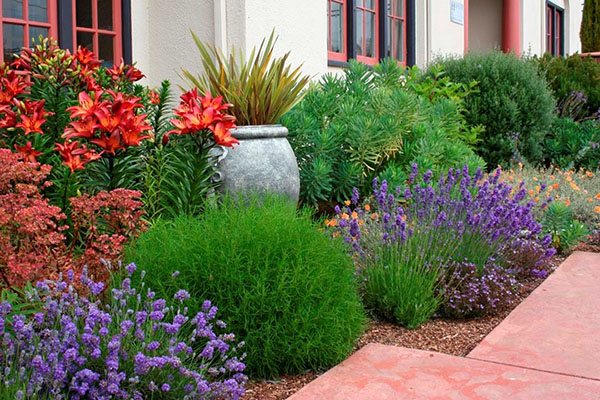

Sage around the recreation area.
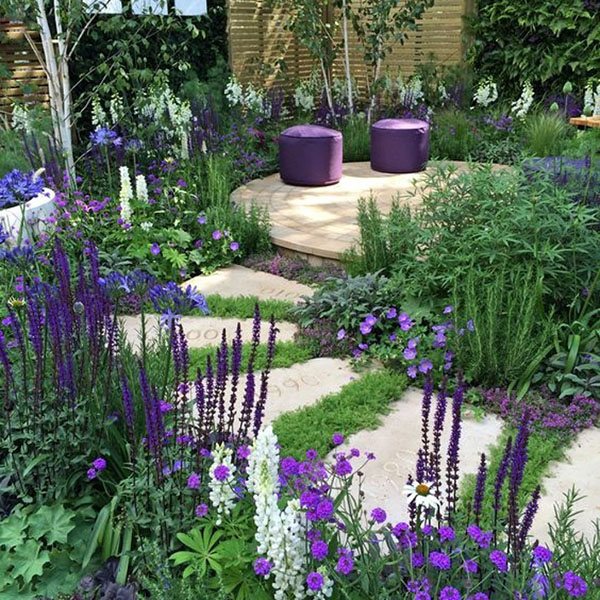

Planting sage seedlings - video
Disadvantages of winter sowing
But now about the cons of this sowing period. The weather conditions in winter and spring are different, and sometimes the abundant snow begins to melt so actively that even with a slight slope it can simply wash off the seeds.The second danger is mice and birds, which also want to eat, and in the absence of snow for a long time or its periodic melting with exposure of the soil, the seeds are in their reach. Of course, this does not threaten all seeds, but, for example, leuzea and agrimony may suffer. And the third danger - you can simply lose seedlings - by the spring, the exact place of sowing and rows is often forgotten.
There is a little trick in this case. If there are few seeds and seedlings do not appear together, then it is better to sow in pots with labels and dig them flush with the soil on the site. I used this technique for Rhodiola rosea, wild garlic and duck peony.
Disease and pest control
In order for sage to grow healthy, it is necessary to fight the insects that threaten it.
Garden booger
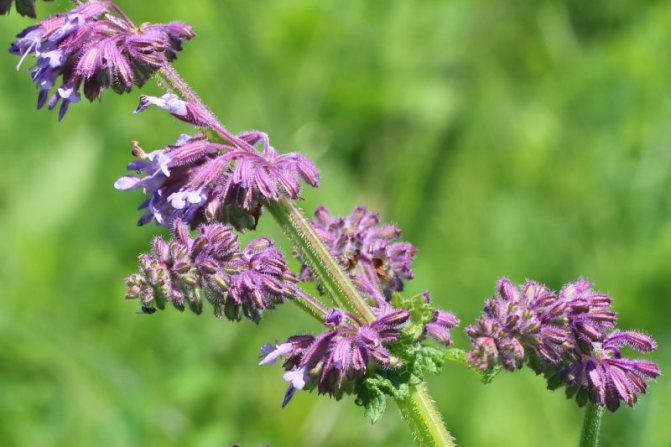

Its larva eats stems and is capable of causing great damage to bushes. To reduce the risk, you need to regularly weed the garden, and if there are many pests, treat the sage with insecticides.
Sage mites
Very small mites stick to the leaves, sucking out the juice. White dry spots remain in these places. Treatment of plants with acaricides will be effective. You can use "Kleschevit", "Akarin" and others.
Sage moth
It looks like a nondescript light brown butterfly. Caterpillars emerge from moth eggs. It is quite difficult to deal with them. In the fall, the earth is dug up to destroy the larvae and pupae. In summer, sage is treated with insecticides such as Fufanon.
Sage weevil
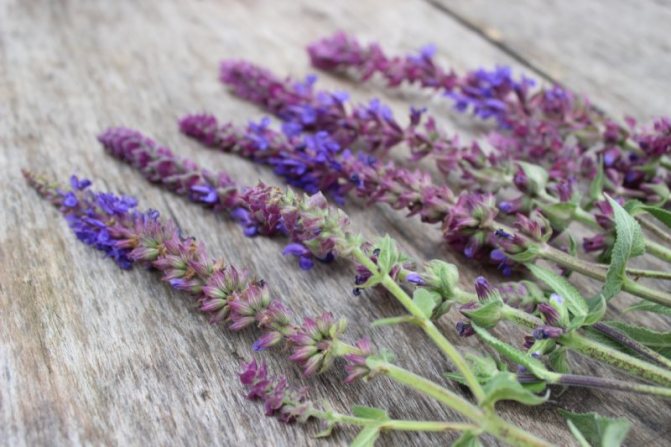

Beetles with a black-brown body and their larvae are also dangerous for sage. In the event of an attack, damaged leaves with small holes can be seen. Plants are sprayed with Aktellik or other acaricides.
Getting ready for wintering
You, of course, did not forget to cover the roses on the site. Meanwhile, medicinal plants need your care and a winter coat. Many of the medicinal plants that hobbyists grow on their plots come from areas with far from similar weather conditions.
For example, lavender, medicinal sage and clary sage, lemon balm, fragrant rue, scumpia and hyssop originate from the Mediterranean, Caucasian dioscorea, madder and elecampane are found in the wild in the Caucasus, araliaceae (eleutherococcus, zamaniha, ginseng) Nippon dioscorea and Dalniy Maclea are genus East. The winters in those areas are very different from ours. How to help plants to endure the critical period? Even Siberian species, which endure the winter without problems, sometimes still present surprises, especially when long thaws alternate with a sharp cold snap.
For example, rue, phytolacca, lavender, bryony and some others are not found in the wild in the middle lane. It is better to cover plants such as licorice and Ural licorice, the aforementioned bryony, American phytolacca and rue, madder dyeing, fennel, Caucasian dioscorea, from the frost with peat. Even a non-southern plant like Hops will also respond gratefully to a blanket of peat or compost. To harbor or not to harbor lavender and sage is a moot point. Sometimes peat increases the likelihood of damping out and uncovered plants overwinter much better than covered ones. Plants such as monarda and lemon balm respond very well to a 3-5 cm layer of peat. But don't overdo it. With too much cover, the likelihood of damping out increases dramatically.
You can paddle the soil a little to the rosettes of perennial foxgloves (ciliate, large-flowered), their rosettes rise with age and this does not contribute to a good overwintering.
Far Eastern exotic species such as Aralia, Zamaniha and Eleutherococcus do not need shelter, but in no case dig the soil around them, even pull out the weeds without zealous hoeing. Their root system is superficial and it is not worth worrying about it, especially before a serious cold test. You can sketch a layer of dry leaves around.Securinega usually freezes by the level of snow cover, but you should not be afraid of this, in the spring it will grow out of dormant buds.
And in general, Far Eastern plants suffer more not even in winter, but from late-spring frosts, which damage not only flowers, but also blossoming leaves and shoots that have begun to grow. This greatly weakens the plants, as they say, not to fat - to be alive. But adding a few buckets of peat would not hurt.
Cover skullcap, clary sage and chicory with spruce branches. Mice are very fond of chewing their roots at their leisure.
Peat can be poured onto madder according to the principle the more, the better - 10-12 centimeters. She not only overwinters better, but the root harvest for the next year is much better.
Consider one more point: if in the south lavender can grow for 20 and 30 years, lemon balm and sage for 5 or more, then in the Non-Black Earth Region these plants winter worse and worse as they age, the roots gradually turn out to be closer and closer to the surface, therefore it is better do not forget to update your small plantation in time and always keep an emergency supply of seeds.
Skumpia leather purpurea
Some plants, for example, witch hazel, are better to be bent to the ground and pinned with a slingshot (as sometimes roses are covered). But the scumpia, despite its very southern origin, I do not harbor, it usually hibernates and so. Although the Dutch red-leaved forms are often naughty.
Also, before the ground is frozen, dig grooves to drain excess moisture during thaws and in spring. If, during a thaw, a layer of water accumulates above the plant, and then freezes, then even hardened plants of Siberia and unpretentious inhabitants of our climate cannot withstand this.
How to grow sage: care secrets
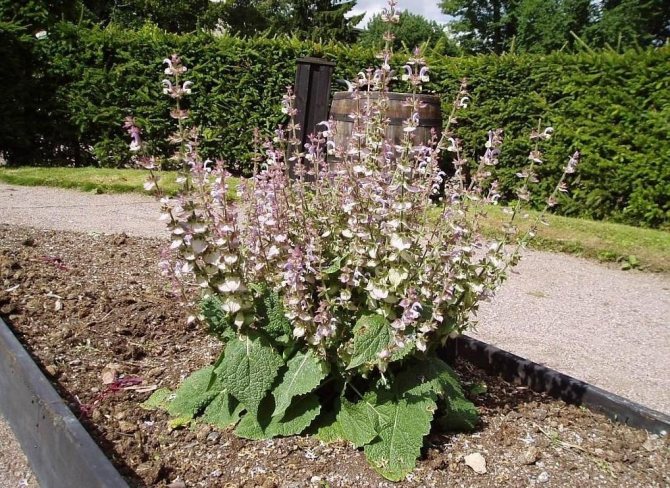

In natural conditions, sage is not particularly favored by attention. Even on poor soils, it grows well on its own, enduring drought and continuing its genus by self-sowing. If you want your bushes to be more lush and bloom profusely, you should give them a little time:
- At first, while the plant gets stronger, water the garden regularly. Also, do not forget about this if the summer was rainless.
- To build a lush cap, decorative species can be fed once before flowering with nitrogen preparations. Perennials are also fed in autumn with a mineral complex for better wintering.
- Repot perennial sage every 4-5 years, separating overgrown bushes.
- Prune perennial species in the fall or spring.
- Cover the remaining overwintering plants with fallen leaves.
It is better to collect sage before flowering or during it, tearing off the tops of the shoots. Raw materials must be dried and stored in paper bags or glass containers under a lid.
Growing seedlings
First of all, we prepare the soil, it will consist of expanded clay and light soil mixture, which can be bought at any specialized store. We put the soil in a container, leaving a distance of a couple of centimeters to the sides. Strongly moisten the container with soil and cover it with glass for half a day. After that, you can safely start sowing seeds. They are very small and should be mixed with sand to avoid complications. After sowing is complete, thoroughly moisten the soil with a spray bottle. Now sprinkle the seeds with crushed earth lightly. The layer should be very thin, a few millimeters. We spray the surface layer of soil from a spray bottle and cover it with glass again.
Salvia care at this stage consists in maintaining the required temperature regime. The container with seeds should be kept at a temperature of 22-26 ° C. Do not forget to periodically ventilate the soil and moisten it a little. Sprouted seeds are in dire need of light and care should be taken to move the box at this time to a well-lit place.
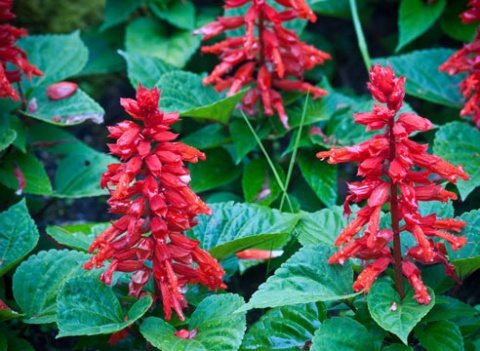

Seedling care
Sage loves nutritious and breathable soil, before planting it is necessary to add humus, compost, river sand to the soil, it is used to loosen the earth. Before planting a plant in the soil, it needs to choose the right place: it is recommended to plant it where cabbage, potatoes and beans grew.
The care is as follows:
- Water sparingly so that water does not accumulate in the soil, loosen the soil in a timely manner.
- Prevent the spread of weeds in large quantities, because of them various diseases will appear on the plant, and they will also muffle its growth.
- Regular feeding, nitrogen is required first, then organic fertilizers. Top dressing with wood ash, which contains a large amount of trace elements, is recommended.
- For the winter period, sage is covered with foliage, which has fallen from the trees, to protect it from frost.
- In autumn or early spring, pruning is required for abundant flowering; after flowering, sage is mowed with an oblique almost to ground level.
- You can transplant the plant for its normal growth and flowering.
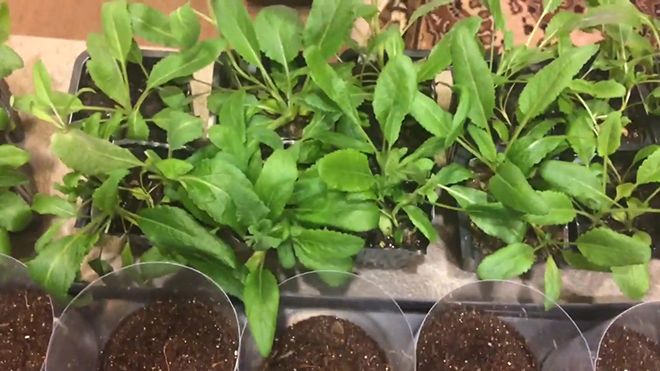

Due to the content of a large amount of essential oils, the plant rarely gets sick. The only vulnerable spot is the root system, which is damaged by abundant watering or frequent rains. If mold appears, it is recommended to treat it with a sulfuric solution, strictly following the instructions. The most dangerous pests are thrips, spider mites, slugs.
In the open field
Planting must be done at a distance of 30 cm from other plants. The optimal place for salvia to grow should be well lit and sheltered from the wind. There are no special requirements for the soil, but it is advisable to lay a drainage layer. The plant loves lime in the soil, but does not tolerate excess organic matter. After planting, you should only take care of timely weed control and thoroughly loosen the soil, avoiding strong compaction. It is necessary to periodically inspect the bush and remove the dead flowers. There is no watering mode as such. You should take care of soil moistening only when there was no rain for a long period and the soil had time to dry well.
Fertilizer costs will be minimal. You will need only a little mineral fertilizers at the very beginning of the growing season.
Pruning has a great effect on the appearance of new shoots. This is extremely beneficial for the beautiful appearance of the salvia. The bush becomes more lush and vibrant.
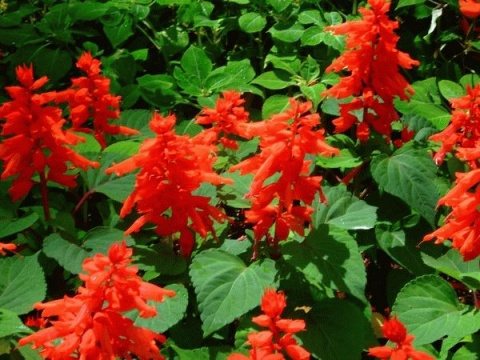

Basic principles of cultivation of salvia officinalis
The homeland of medicinal sage is Italy. Therefore, in our territory, in the wild, it does not occur. Although in the forests, oak forests, fields, its relatives grow: meadow and forest sage, which tolerate frosts and droughts well, but do not have medicinal properties.
To grow medicinal sage on a garden bed, you need to take into account its preferences:
- Sunny areas, possible with a little shade.
- Sandy soil. If the soil is clay, then you need to add river sand and humus and dig everything thoroughly a couple of weeks before planting. Chernozem soils are also not very favorable for sage cultivation. It stretches strongly, gives weak flowering.
- Neutral substrate environment.
- Moderate watering, no overflow. Drought tolerates more easily than waterlogging.
- In latitudes with moderate winters, it winters well, when covered with leaves, snow or spruce branches.
- Good soil aeration is needed. Therefore, loosening the soil around the bushes is encouraged.
- He does not like tightness and constraint. Therefore, it is necessary to adhere to an interval of 20 cm between bushes and 40-50 cm between rows when planting.
- Continuously prune the sage bush, starting from the second year. If you do not do this, then the bushes will stretch out strongly, the lower leaves will fall off, the flowering will be poor. The plant itself will age quickly.
Preparing for winter
Most attention will need to be paid to the plant in mid-autumn.The bushes should be carefully trimmed and the winter coat taken care of. This requires two layers of warm clothing. First, we lay the garden compost, after which we cover the plant with dry foliage. But this will not be a 100% guarantee that the salvia will be preserved by the spring. As a safety net, you can use a more reliable and proven method. Dig up some part of the rhizomes and place them in the cellar during the cold season. This is a good wintering option for Salvia.
When to harvest sage?
Sage is harvested both in summer and autumn.
Summer harvest usually begins in the 3rd decade of June, when the inflorescences bloom. During this period, sage contains the most essential oils, so the plant is suitable for medicinal purposes, and for cooking - as a seasoning. Intact shoots with foliage, as well as buds, are dried. Sage is harvested until mid-July.
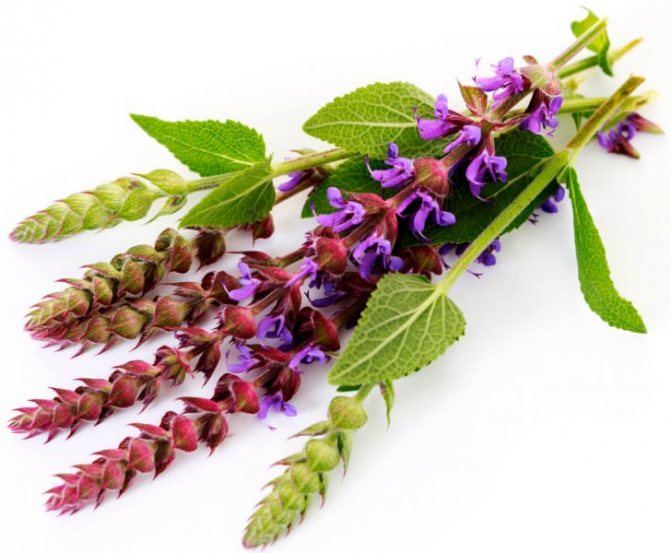

In autumn, the collection begins from the end of September, and it lasts 2-3 weeks. By this time, the greenery is growing again on the cut bushes, which is used.
Sage in summer and autumn - only need to be harvested during dry weather.
Planting a plant
Different types of sage are ambiguous about equal conditions. Oak and meadow prefer sunny areas and moderate watering. These are drought-resistant plants for which waterlogging is dangerous. Clary sage naturally lives on the edges of the forest, so light shade and moist soil are of the highest priority for it.
Despite the differences, there are general requirements:
- salvias grow more readily on light sandy loam soils;
- prefer humus-rich soil of normal acidity (pH = 6.5);
- require shelter for the winter;
- need spring pruning.
Sage is very thermophilic, so it needs to be covered well for the winter.
Since sage is a thermophilic plant, some perennial species are grown as one or two years in regions with harsh winters.
Important! Sage is a cross-pollinated plant, therefore, to preserve species characteristics, different varieties are planted at some distance.
Varieties and varieties
The Latin name of the plant "Salvia" in the Russian interpretation means "to be healthy." Photo culture is often the hallmark of pharmaceuticals. It is a perennial herb, a shrub. Stems are tetrahedral, erect, reaching a height of 1.2 m. Shoots are densely covered with wedge-shaped leaves 4 to 8 cm long and 1 to 3 cm wide. The shape of the inflorescence is a spikelet or panicle. Small bright flowers bloom in mid-July and bloom until late autumn.
Sage is not only a beautiful but also a very useful plant.
The most common types are:
Salvia officinalis
(S.officinalis) is a plant reaching a height of 20-70 cm. The leaves are elongated, narrow (0.8-1.5 cm), densely pubescent, gray-green in color, the stem is covered with whitish villi. It is widely used in cooking, medicine and cosmetology. Varieties:
- Breeze is a semi-shrub up to 60 cm high with jagged leaves and blue-blue flowers;
- Aibolit is a tall plant (up to 120 cm), distinguished by wrinkled dark green foliage with a strong edge;
Salvia officinalis
- Nectar is a medium-sized bush, reaching 1 m in height. Leaves are light green, strongly pubescent. Spike-shaped inflorescences are strewn with purple or blue flowers;
- Semko Patriarshy is a low plant (50-70 cm) with long (up to 10 cm) leaves that densely cover the stalk stiff from below.
Forest sage
(oak, wild - S. nemorosa) is a spice plant found on the edges of forests and on hillsides in the Mediterranean countries. The stem is herbaceous, the leaves are narrow, lanceolate. The flowers are collected in spike-shaped inflorescences of the violet or blue spectrum. Varieties:
- undersized - Plumosa, Blue and Pink Queen, Marcus - reach a height of 25 to 50 cm, bloom with pink, purple, blue and purple flowers;
Forest sage
- tall - Adrian, Caradonna, Mainacht, Ametist - peduncles reach a height of up to 90 cm, dense spike-shaped inflorescences convey a wide range of colors - from white-pink delicate shades to deep violet-blue.
Meadow sage
(S.pratensis) and
Clary sage
(S.glutinosa) is a species of oak sage. Sh. Sticky deserves attention because of the unusual greenish-yellow color of the leaves. Interesting photos, where lush paniculate inflorescences of a pale yellow color create a delicate background for brighter flowers.
Meadow sage
Reproduction
Sage can be propagated in several ways. Experienced gardeners can easily navigate in them and can propagate shrubs with any of them. So, for example, you can propagate a flower by dividing the bush, cuttings, seeds and vegetatively. Everyone chooses the most convenient option for him. It should be borne in mind that the most important thing is to reproduce correctly, then in the future there will be no problems with growth and development.
By dividing the bush
Dividing a bush is one of the most common breeding methods. It is best to do this in the spring, when the frosts have already receded. After the young shoots appear, the bushes should be dug up and carefully divided into parts. You can divide it with your hands or with a sharp shovel. The number of parts is determined by the size of the bush. There can be two or more of them. You can also divide the root system with pruning shears, which should be disinfected in advance.
Cutting is also a convenient way... With it, the shoots are cut off with a sharp object, four buds are left on them. At the same time, the leaves are preserved, and one bud should lie in the ground. After that, the plant is planted in a special container. Then you should water and cover the young shoot with a film. Do not forget to air the flower. In a month, the first full-fledged roots will begin to appear. Then you can plant it in open ground.
Rooting occurs quickly enough, so propagation by cuttings is very effective.
Sage can also be propagated by seeds, but this is not entirely effective, since only half will rise. Seeds are planted in a tray in spring. Then it is placed in a dark, warm place. The soil needs to be watered regularly to maintain moisture. After 3 weeks, the first shoots will appear. After that, you need to put the tray in a bright place, and when they grow up, you will need to transplant it into a separate container. This is done with extreme caution. Then the plant is transplanted into open ground, and it begins to develop on its own.
The last vegetative method involves bending the shoot to the ground. It is pinned with a bracket and covered with earth. And after a few months, the new root system will be able to grow on its own. Then the shrub is separated and allowed to develop fully. This method is not used very often, but it is still popular among some gardeners.

